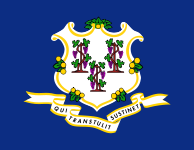- Flag of Connecticut
-
Flag of Connecticut
Use Civil and state flag 
Adopted September 9, 1897 Design White shield with three grapevines on a field of azure blue. The flag of the state of Connecticut consists of a white baroque shield with three grapevines (each bearing three bunches of purple grapes) on a field of azure blue. The banner below the shield reads "Qui Transtulit Sustinet", ("He who transplanted still sustains"), the state's motto. The flag dimensions are 5.5 feet (1.7 m) in length and 4.33 feet (1.32 m) in width.[1]
Contents
History
The Connecticut General Assembly approved the flag in 1897 after it was introduced by Governor Owen Vincent Coffin in 1895.[2]
The design comes from the seal of Saybrook Colony when it was established in 1639. That seal depicted 15 grapevines and a hand in the upper left corner with a scroll reading "Sustinet qui transtulit". When Connecticut Colony bought Saybrook in 1644, the seal transferred to Connecticut Colony. On October 25, 1711, the governor and legislature changed the seal. They reduced the number of grapevines from 15 to three, in order to represent the three oldest settlements (Windsor, Wethersfield, and Hartford)[3] (or possibly the three separate settlements, Connecticut Colony, Saybrook Colony, and New Haven Colony, which had been absorbed into Connecticut by that time) and rearranged the wording and position of the motto.
In 2001, the North American Vexillological Association surveyed its members on the designs of the 72 U.S. state, U.S. territorial and Canadian provincial flags. The survey found the Connecticut flag to be ranked in the bottom 25, ranked 50th out of the 72.[4]
Flying the flag at half mast
The flag is traditionally at half mast when the American flag is flown at half mast, which may be ordered by the President or by the Governor.[5] According to 2007-R-0624, only the governor of Connecticut may decide to fly the state flag at half mast, though the right is a power of office and not a law. Typically this is done upon the death of a Connecticut resident in the armed forces,[6] but has been done in the past for the funerals of past state governors, state representatives,[7] or for an event considered tragic for the state.
See also
- State of Connecticut
- Symbols of the state of Connecticut
- Great Seal of the State of Connecticut
- Coat of Arms of Connecticut
- Symbols of the state of Connecticut
References
- ^ http://www.ct.gov/ctportal/cwp/view.asp?a=885&q=246492
- ^ http://www.ct.gov/ctportal/cwp/view.asp?a=885&q=246492
- ^ http://www.jud.ct.gov/external/news/sctour/texttour.htm
- ^ http://www.nava.org/Flag%20Design/State&Provincial%20Survey%202001/surveyresults.htm
- ^ http://www.senatedems.ct.gov/enews/archive/Duff-1001-web.html
- ^ http://www.cga.ct.gov/2007/rpt/2007-R-0624.htm
- ^ http://www.ct.gov/governorrowland/cwp/view.asp?A=1336&Q=257894
External links
Flags of the US states, federal district, and insular areas States - Alabama
- Alaska
- Arizona
- Arkansas
- California
- Colorado
- Connecticut
- Delaware
- Florida
- Georgia
- Hawaii
- Idaho
- Illinois
- Indiana
- Iowa
- Kansas
- Kentucky
- Louisiana
- Maine
- Maryland
- Massachusetts
- Michigan
- Minnesota
- Mississippi
- Missouri
- Montana
- Nebraska
- Nevada
- New Hampshire
- New Jersey
- New Mexico
- New York
- North Carolina
- North Dakota
- Ohio
- Oklahoma
- Oregon
- Pennsylvania
- Rhode Island
- South Carolina
- South Dakota
- Tennessee
- Texas
- Utah
- Vermont
- Virginia
- Washington
- West Virginia
- Wisconsin
- Wyoming
Federal district Insular areas  State of Connecticut
State of ConnecticutTopics - Index
- Culture
- Constitution
- Delegations
- Elections
- Geography
- Government
- History
- Images
- People
- Visitor Attractions
Regions Counties Cities Places Categories:- United States state flags
- Symbols of Connecticut
- Flags of Connecticut
- State of Connecticut
Wikimedia Foundation. 2010.
